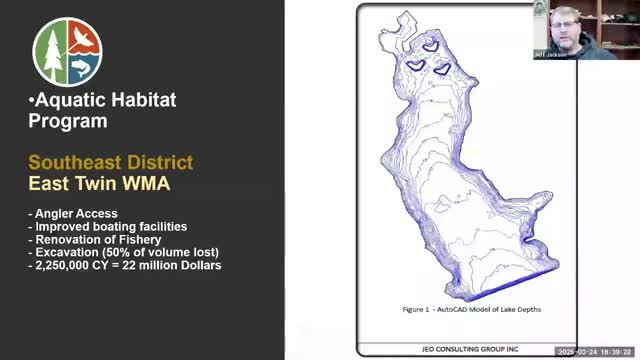State agency outlines 15-year plan for 71 aquatic habitat enhancement projects
May 23, 2025 | Nebraska Game and Parks Commission (NGPC), State Agencies, Organizations, Executive, Nebraska
This article was created by AI summarizing key points discussed. AI makes mistakes, so for full details and context, please refer to the video of the full meeting. Please report any errors so we can fix them. Report an error »

The Nebraska Game and Parks Commission (NGPC) has unveiled an ambitious 15-year Statewide Aquatic Habitat Plan, aiming to revitalize and enhance water bodies across the state. During a recent meeting, officials outlined key projects that promise to improve access for anglers and restore vital aquatic ecosystems.
One of the most pressing issues discussed was the significant sedimentation affecting local reservoirs. For instance, a reservoir has lost 50% of its volume over the past 60 years, equating to approximately 2.25 million cubic yards of sediment. Restoring this reservoir to its original condition would cost an estimated $22 million, a daunting figure that highlights the scale of the challenges ahead. Instead, the NGPC plans to undertake selective excavation to improve access and manage sediment without a full restoration.
The Northwest district, which boasts the largest number of water bodies in Nebraska, is set to see 21 projects initiated. Among these, improvements at Smith Lake Wildlife Management Area (WMA) will focus on enhancing angler access and addressing maintenance needs for an aging outlet structure. The project aims to make fishing more accessible, particularly during the later months of the year when vegetation can hinder access.
Another significant project involves the removal of the Carter P Johnson Dam, which has become heavily sedimented over the years. This project will not only restore the stream channel but also enhance habitat along the waterway. Excitingly, the NGPC has secured nearly $3.5 million in grants to fund over half of this project, allowing for a more robust approach to restoration efforts.
In the Northeast region, attention was drawn to Niobrara State Park, where a consulting firm has been hired to investigate a leaking pond. The goal is to determine whether the issue stems from a leak or insufficient water budget to maintain the pond's levels.
Overall, the NGPC's plan encompasses 71 projects aimed at improving aquatic habitats across Nebraska. This comprehensive approach not only addresses immediate concerns but also sets a framework for collaboration with other agencies and stakeholders. As the NGPC moves forward, residents can look forward to enhanced recreational opportunities and healthier aquatic ecosystems in their communities. For more details, the public is encouraged to visit the NGPC website, where the full aquatic habitat plan is available for review.
One of the most pressing issues discussed was the significant sedimentation affecting local reservoirs. For instance, a reservoir has lost 50% of its volume over the past 60 years, equating to approximately 2.25 million cubic yards of sediment. Restoring this reservoir to its original condition would cost an estimated $22 million, a daunting figure that highlights the scale of the challenges ahead. Instead, the NGPC plans to undertake selective excavation to improve access and manage sediment without a full restoration.
The Northwest district, which boasts the largest number of water bodies in Nebraska, is set to see 21 projects initiated. Among these, improvements at Smith Lake Wildlife Management Area (WMA) will focus on enhancing angler access and addressing maintenance needs for an aging outlet structure. The project aims to make fishing more accessible, particularly during the later months of the year when vegetation can hinder access.
Another significant project involves the removal of the Carter P Johnson Dam, which has become heavily sedimented over the years. This project will not only restore the stream channel but also enhance habitat along the waterway. Excitingly, the NGPC has secured nearly $3.5 million in grants to fund over half of this project, allowing for a more robust approach to restoration efforts.
In the Northeast region, attention was drawn to Niobrara State Park, where a consulting firm has been hired to investigate a leaking pond. The goal is to determine whether the issue stems from a leak or insufficient water budget to maintain the pond's levels.
Overall, the NGPC's plan encompasses 71 projects aimed at improving aquatic habitats across Nebraska. This comprehensive approach not only addresses immediate concerns but also sets a framework for collaboration with other agencies and stakeholders. As the NGPC moves forward, residents can look forward to enhanced recreational opportunities and healthier aquatic ecosystems in their communities. For more details, the public is encouraged to visit the NGPC website, where the full aquatic habitat plan is available for review.
View full meeting
This article is based on a recent meeting—watch the full video and explore the complete transcript for deeper insights into the discussion.
View full meeting
